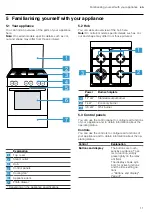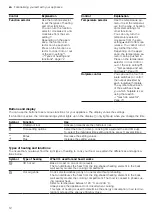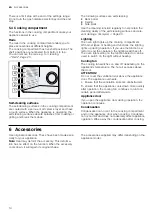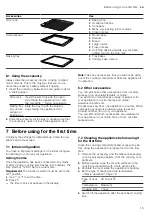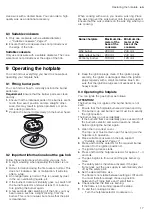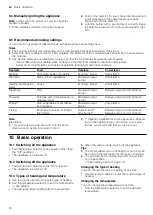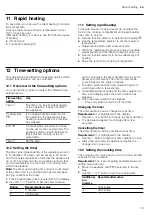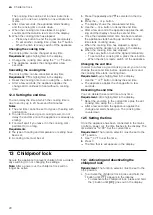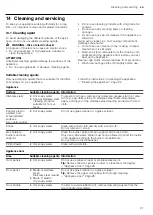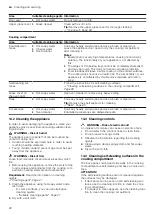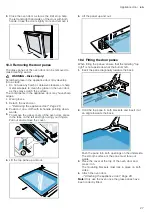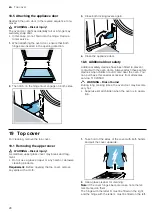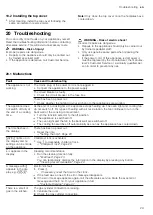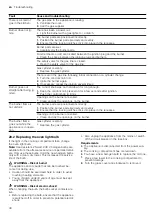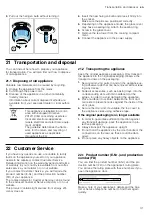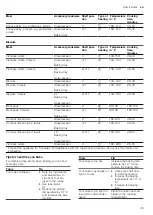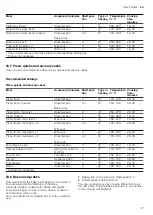
en
Cleaning and servicing
22
Area
Suitable cleaning agents Information
Door seal
¡
Hot soapy water
Do not remove or scrub.
Upper glass cover
¡
Glass cleaner
Clean with a soft cloth.
Tip:
Remove the upper glass cover for thorough cleaning.
Cooking compartment
Area
Suitable cleaning agents Information
Enamelled sur-
faces
¡
Hot soapy water
¡
Vinegar water
¡
Oven cleaner
Soak any heavily soiled areas and use a brush or steel wool.
Leave the appliance door open to dry the cooking compartment
after cleaning it.
Notes
¡
Enamel burns at very high temperatures, causing minor discol-
ouration. The functionality of your appliance is not affected by
this.
¡
The edges of thin baking trays cannot be completely enamelled
and may be rough. This does not impair corrosion protection.
¡
Food residues will leave a white coating on the enamel surfaces.
The coating does not pose a health risk. The functionality of your
appliance is not affected by this. Remove residues with lemon
juice.
Self-cleaning sur-
faces
-
Follow the instructions for self-cleaning surfaces.
→
"Cleaning self-cleaning surfaces in the cooking compartment",
Glass cover on
the oven light
¡
Hot soapy water
Use oven cleaner to remove very heavy soiling.
Rails
¡
Hot soapy water
Soak any heavily soiled areas and use a brush or steel wool.
Tip:
Remove the shelf supports for cleaning.
Accessories
¡
Hot soapy water
¡
Oven cleaner
Soak any heavily soiled areas and use a brush or steel wool.
Enamelled accessories are dishwasher-safe.
14.2 Cleaning the appliance
In order to avoid damaging the appliance, clean your
appliance only as specified, and using suitable clean-
ing products.
WARNING ‒ Risk of burns!
The appliance and its parts that can be touched be-
come hot during use.
▶
Caution should be exercised here in order to avoid
touching heating elements.
▶
Young children under 8 years of age must be kept
away from the appliance.
WARNING ‒ Risk of fire!
Loose food remnants, fat and meat juices may catch
fire.
▶
Before using the appliance, remove the worst of the
food residues and remnants from the cooking com-
partment, heating elements and accessories.
Requirement:
Read the information on cleaning
agents.
→
1.
Clean the appliance using hot soapy water and a
dish cloth.
‒
For some surfaces, you can use alternative
cleaning agents.
→
"Suitable cleaning agents", Page 21
2.
Dry with a soft cloth.
14.3 Cleaning controls
WARNING ‒ Risk of electric shock!
An ingress of moisture can cause an electric shock.
▶
Do not detach the control knobs to clean them.
▶
Do not use wet sponge cloths.
1.
Observe the information regarding the cleaning
agents.
2.
Clean using a damp sponge cloth and hot soapy
water.
3.
Dry with a soft cloth.
14.4 Cleaning self-cleaning surfaces in the
cooking compartment
The back panel, ceiling and side walls in the cooking
compartment are self-cleaning and have a coarse sur-
face.
ATTENTION!
If the self-cleaning surfaces are not cleaned regularly,
the surfaces may be damaged.
▶
If dark spots can be seen on the self-cleaning sur-
faces, use the cleaning function to clean the cook-
ing compartment.
▶
If a request to clean appears, use the cleaning func-
tion to clean the cooking compartment.




